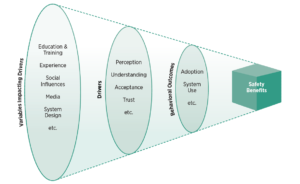
User Interactions with Vehicle Automation Technologies: A Review of Previous Research and a Proposed Framework
This research brief reviews recent research and proposes a framework on user perceptions, understanding, and interactions with vehicle automation technology.
January 2023
Suggested Citation
Abstract
Introduction
There has been growing interest and continuous investment during the past two decades to advance transportation technologies with the vision that automated vehicles (AVs) will be deployed widely and transform the future of transportation. For AVs to reach their intended safety benefit potentials, users will have a critical role. This role is integral on two major fronts. First, public perception and acceptance of technologies will impact the rate at which these vehicles penetrate the market as well as the frequency with which the technologies are utilized. Second, correct understanding on the capabilities and limitations of technologies will help users calibrate their expectations and behaviors, leading to safe and appropriate interactions with the technology. It stands that education and training play an integral role on both fronts as they can help shape perceptions of technology while also ameliorating knowledge and understanding of how it works.
These three elements (user perceptions, user understanding, and education and training) provide the backdrop for this document, which presents a high-level review of recent research in these areas. Additionally, a framework is proposed that depicts the relationships between the topics listed above to help enable proper interactions between users and technologies.
Key Findings
A framework, presented below, depicts the interrelationship between many of the concepts and outcomes discussed throughout this research brief. This proposed framework shows three major areas that will influence the safety benefits of vehicle technologies for drivers and other road users: (1) variables impacting drivers; (2) drivers; and (3) behavioral outcomes.

Variables Impacting Drivers
There are a number of variables that will impact drivers, such as education and training, media, experience, and exposure, as well as the characteristics of the technology and user interface itself, which can affect or shape drivers’ perceptions, understanding, acceptance, and trust of vehicle technologies. As an example, education and training can impact a driver’s understanding of vehicle technology, which in turn can influence how they use the system and the subsequent safety benefits from the technology. Similarly, negative media surrounding a new vehicle technology could adversely impact an individual’s acceptance or trust, which can limit their adoption or use, and result in little or no safety benefits.
Drivers
There are various factors that will influence drivers’ perceptions of vehicle technology and automation, their level of understanding (or mental models) and acceptance, and their trust in the technology. As an outcome, drivers will adopt certain behaviors and use systems according to their understanding and level of comfort. These behavioral outcomes may not result in the intended safety benefits of the technology.
Behavioral Outcomes
Behavioral outcomes of drivers, including adoption (i.e., uptake of new technology) and actual system use (including the manner in which technology is employed by drivers) play a key role in whether safety benefits of a vehicle technology can be fully realized. Positive behavioral outcomes lead to proper technology utilization and maximizing safety benefits while negative behavioral outcomes could yield opposite results.
Suggested Citation